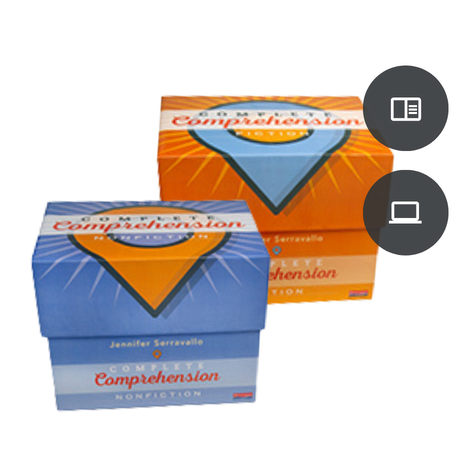Overview
-
Year Levels 3–6
-
Curriculum ACT, NSW, NT, QLD, SA, TAS, VIC, WA, NZ
-
Subject Literacy
-
Resource Formats Print, Digital
-
Learning Focus Comprehension and text types
What it is
Jennifer Serravallo’s Complete Comprehension uses whole chapter books to connect assessment, evaluation and teaching in one classroom solution. A comprehension cycle mapped to Fountas & Pinnell Levels J–W enables educators to determine:
- the skills and needs of each reader
- map progress by prioritising goals
- plan and provide teaching that matches a student’s needs.
Meet the author
Jennifer Serravallo
Jennifer Serravallo began her career in education as a teacher in New York City public schools and later joined the Teachers College Reading and Writing Project at Columbia University (TCRWP).
Through TCRWP and now as an independent consultant, she has spent over a decade helping teachers across the country to create literacy classrooms where students are joyfully engaged and the instruction is meaningfully individualised to students' goals. She is the author of the New York Times bestseller The Reading Strategies Book as well as many other popular titles.
What it includes
Discover how Jennifer Serravallo’s Complete Comprehension benefits learners.
Complete Comprehension Framework
Assess
- Complete Comprehension includes 28 authentic trade books (two each at levels J to W) by award-winning and beloved authors on topics of interest to young readers.
- A student chooses from among the texts, then reads independently. As they read, labels affixed in the book cue them to pause their reading and write their answer in response to open-ended prompts on a provided response form.
- No instructional time is required to obtain these written assessments: Students read and answer prompts on their own while teachers can continue working with other students who are not engaged in the assessment.
- The Assess guide includes instructions on how to introduce the assessment to the whole class, how to gather and prepare your resources, how to administer the assessment with individual students, how to support book selection, and how and when to assess students.
- All prompts for all 28 books are also included for easy reference.
Complete Comprehension Framework
Evaluate
- Once you've received a student's response form, Jen's common-sense rubrics in the Evaluate guide help you make sense of the responses and pinpoint opportunities for growth.
- Spend a short amount of time with these rubrics and your student's response form in hand, typically 10 to 15 minutes when you first start getting to know the rubrics, and as little as 5 minutes with increased proficiency.
- Sample student responses from Jen's own field research, keyed to the progressions she shared in Understanding Texts & Readers, help you determine whether a reader is approximating a skill, is proficient with it, or demonstrates exceptional understanding.
- Once you've evaluated each response on the form, use the Planning Form, a quick tally sheet, and the if-then table that recommends clear next steps pinpointed to the reader's strengths and needs.
- The Evaluate guide includes a 4-step protocol for evaluation, suggestions for getting the most out of the rubrics, summaries of each included trade book, guidance on what to look for in students' responses, and sample student responses.
Complete Comprehension Framework
Teach
- Complete Comprehension provides 100+ strategies in the Teach guide: 75+ strategies unique to Complete Comprehension and 20+ variations on some of the most foundational strategies from The Reading Strategies Book.
- Each strategy is on its own page and formatted just like those in The Reading Strategies Book, with classroom charts, lesson language, and mentor text suggestions.
- Organised with a chapter for each of Jen's four comprehension goals for fiction and reader engagement, the Teach guide makes selecting the most beneficial strategy for a student easy.
Complete Comprehension components
Complete Comprehension Fiction
Complete Comprehension Fiction includes:
- 28 high-quality trade titles
- a unique whole-book assessment
- evaluation rubrics
- 100+ reading strategies to share with readers.
Chapter books challenge readers' ability to synthesise and accumulate information and sustain comprehension. Longer texts require readers to be more skilled around the goals of:
- sustaining understandings about plots that have many events, and may include events out of order (flashback, foreshadowing)
- visualising settings which often change from chapter to chapter, and which may be unfamiliar to the reader
- tracking characters and their growth, changes, and relationships across time
- handling more difficult vocabulary and the richer use of figurative language
- determining themes by considering an entire long text and using the book to uncover the meaning of symbolism.
Complete Comprehension components
Complete Comprehension Non-fiction
Complete Comprehension Nonfiction includes:
- 28 high-quality trade titles
- a unique whole-book assessment
- evaluation rubrics
- 100+ reading strategies to share with readers.
As nonfiction books become more sophisticated, they challenge students' ability to synthesise and accumulate information and sustain comprehension. Longer texts require readers to be more skilled around the goals of:
- determining the main idea of sections, chapters, and the whole book
- identifying and separating key details from extraneous information, and understand the relationship between facts
- figuring out the meaning of content-specific, technical vocabulary by using the text and features
- using text features to support and deepen understanding.
Samples & downloads
- Complete Comprehension - Research summary for Complete Comprehension Download PDF (551KB)
- Complete Comprehension - Goal directed comprehension instruction guide Download PDF (6.5MB)
- Complete Comprehension - FAQs Download PDF (2.9MB)







